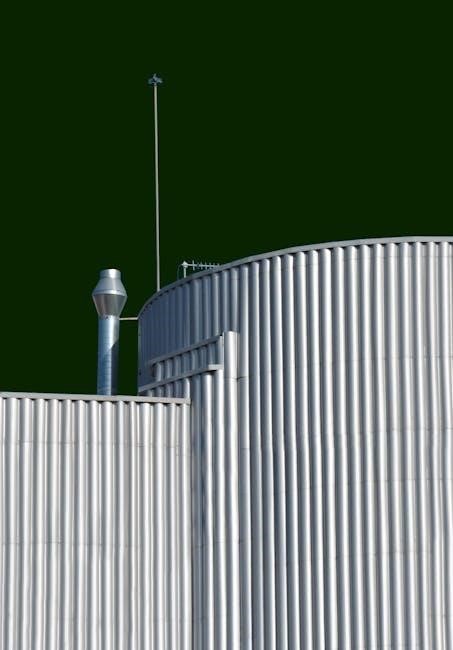Steam boiler piping diagrams are essential tools for understanding and managing steam systems, ensuring proper installation, maintenance, and operation․ They provide a visual representation of components, connections, and flow, helping engineers and technicians comply with industry standards and best practices for safety and efficiency․ These diagrams are widely available in PDF formats, offering detailed layouts and configurations for various steam boiler setups, from single-boiler systems to complex multi-boiler arrangements with reverse return piping․ By following these diagrams, professionals can ensure optimal performance, troubleshoot issues, and maintain system integrity effectively․
1․1 Importance of Piping Diagrams in Steam Boiler Systems
Steam boiler piping diagrams are critical for ensuring safe and efficient system operation․ They provide clear visual guidance for installation, maintenance, and troubleshooting, reducing risks of errors․ These diagrams help technicians understand flow paths, component connections, and safety features, ensuring compliance with industry standards․ Proper piping layouts prevent issues like water hammer and corrosion, while also optimizing steam distribution and condensate return․ Accurate diagrams are essential for training and compliance, ensuring systems run reliably and safely over their lifespan․
1․2 Overview of Steam Boiler Piping Diagram PDFs
Steam boiler piping diagram PDFs are comprehensive guides detailing system layouts, component connections, and best practices for installation and maintenance․ These documents typically include detailed schematics for single- and multi-boiler setups, as well as configurations for condensate return and steam distribution․ They often cover safety protocols, material specifications, and compliance standards, serving as indispensable resources for engineers and technicians to design, troubleshoot, and optimize steam boiler systems effectively․
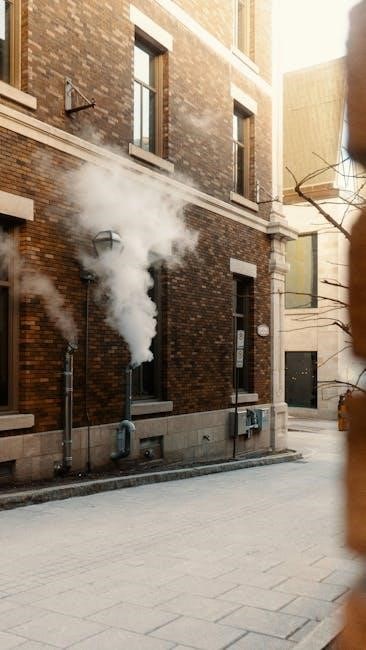
Understanding Steam Boiler Systems
Steam boiler systems are classified by piping arrangements, pressure conditions, and condensate return methods, ensuring efficient steam distribution and system reliability in industrial and commercial applications․
2․1 Basic Components of a Steam Boiler
A steam boiler system comprises essential components such as the boiler vessel, burner, heat exchanger, steam outlet, water inlet, and safety devices․ The burner generates heat, while the heat exchanger transfers it to water, producing steam; Pumps circulate water, and controls regulate pressure and temperature․ Proper installation and maintenance of these components, as detailed in piping diagrams, ensure efficient and safe operation, preventing issues like water hammer and corrosion while optimizing steam distribution and system reliability․
2․2 Steam Boiler Classification Based on Piping Arrangements
Steam boilers are often classified based on their piping configurations, which determine how steam and condensate flow through the system․ Common classifications include one-pipe and two-pipe systems, each with distinct advantages․ One-pipe systems use a single pipe for both steam supply and condensate return, while two-pipe systems separate these functions․ Additionally, gravity return and forced circulation systems are classified based on how condensate is returned to the boiler․ Proper classification ensures efficient operation and aligns with industry standards, as detailed in piping diagrams․
Key Components of Steam Boiler Piping Systems
Key components include main steam piping, return piping, condensate systems, safety valves, and pressure relief devices․ These elements ensure efficient steam distribution, condensate return, and system safety․
3․1 Main Steam Piping
Main steam piping is critical for transporting steam from the boiler to various applications, ensuring minimal pressure drop and heat loss; Proper sizing, material selection, and installation are essential to maintain efficiency and safety․ Diagrams often illustrate one-pipe or two-pipe configurations, with considerations for pipe sizing based on parallel or counterflow systems․ These configurations ensure condensate flows efficiently, preventing water hammer and corrosion; Additionally, correct support and insulation practices are highlighted in piping diagrams to optimize system performance and longevity․
3․2 Return Piping and Condensate Systems
Return piping and condensate systems are vital for efficiently returning condensed steam to the boiler, ensuring continuous operation and energy efficiency․ These systems include gravity return, forced circulation, and dry return configurations․ Proper sizing and installation of return piping prevent water hammer and corrosion․ Condensate tanks, traps, and pumps are key components, as they handle the collection and return of condensate․ Piping diagrams detail these components and their connections, emphasizing proper drainage and isolation valves for maintenance and safety․
3․3 Safety Valves and Pressure Relief Devices
Safety valves and pressure relief devices are critical components in steam boiler piping systems, ensuring safe operation by relieving excess pressure․ Properly sized and installed, these devices prevent over-pressurization and potential system failure․ Piping diagrams detail their placement and connections, emphasizing compliance with industry standards․ Blowdown systems also play a role in maintaining safety by removing sediment and contaminants, ensuring optimal boiler performance and longevity․
Types of Steam Boiler Piping Systems
Steam boiler piping systems include one-pipe, two-pipe, gravity return, and forced circulation configurations․ Each system design ensures efficient steam distribution and condensate return, tailored to specific applications․
4․1 One-Pipe Steam Systems
A one-pipe steam system uses a single pipe to supply steam and return condensate, ensuring efficient space utilization and simplified installation․ This configuration relies on steam traps to separate condensate from the steam flow, preventing backflow and maintaining system integrity․ Proper sizing of the steam main and risers is critical to avoid pressure drops and ensure even distribution․ Additionally, the system often incorporates components like check valves and strainers to enhance performance and longevity․ Regular maintenance of traps and piping is essential to prevent issues such as water hammer and corrosion, ensuring optimal system operation․
4․2 Two-Pipe Steam Systems
A two-pipe steam system uses separate pipes for steam supply and condensate return, enhancing efficiency and heat control․ This setup allows for better management of steam distribution and condensate drainage․ Steam traps are essential to prevent condensate from entering the steam main, ensuring smooth operation․ Proper sizing of both supply and return lines is critical to maintain pressure and flow balance․ Diagrams for two-pipe systems detail component placements, aiding in installation and troubleshooting, while ensuring compliance with safety and performance standards․
4․3 Gravity Return Systems
4․4 Forced Circulation Systems
Forced circulation systems use pumps to actively circulate condensate and steam, ensuring consistent flow and heat transfer․ These systems are ideal for high-pressure and large-capacity applications, offering improved efficiency and reliability․ Piping diagrams for forced circulation systems detail pump placement, pipe sizing, and flow paths, ensuring optimal performance․ They are commonly used in industrial settings where precise control over steam distribution is critical․ Proper installation and maintenance, guided by detailed PDF diagrams, are essential to prevent issues like water hammer and ensure long-term system integrity․
Best Practices for Designing Steam Boiler Piping Systems
Proper sizing, material selection, and insulation are critical for efficient steam boiler piping systems․ Always follow industry standards and consult detailed PDF diagrams for precise configurations and safety compliance․
5․1 Proper Sizing of Steam Piping
Proper sizing of steam piping is critical to ensure efficient system performance and safety․ Correct pipe sizing reduces pressure drops, prevents erosion, and maintains optimal steam velocity․ Always consult steam boiler piping diagrams in PDF formats for precise sizing guidelines․ Armstrong’s best practices recommend sizing mains one size larger in one-pipe systems to accommodate condensate flow․ Pressure drop and steam velocity calculations are essential for accurate sizing, ensuring reliable operation and minimizing energy losses across the system․
5․2 Material Selection for Piping Components
Material selection for steam boiler piping components is crucial for durability and safety․ Common materials include annealed copper tubing (ASTM B 88) and black steel pipe (ASTM A 53), chosen for their strength and thermal resistance․ Wrought-copper fittings (ASME B16․22) are also widely used․ Material choice must consider operating pressures, temperatures, and corrosion risks․ Always refer to steam boiler piping diagrams in PDFs for compliant material specifications, ensuring system longevity and reliability under varying conditions;
5․3 Insulation and Heat Loss Prevention
Insulation is critical for minimizing heat loss in steam boiler piping systems, improving efficiency and reducing energy costs․ Materials like fiberglass, mineral wool, or foam insulation are commonly used, with thickness determined by pipe size and temperature․ Proper insulation prevents condensation and ensures consistent steam quality․ Heat loss prevention also involves correct piping sizing and material selection․ Referencing steam boiler piping diagrams in PDFs ensures accurate insulation installation, maintaining system performance and safety while adhering to industry standards for thermal management․
Installation Guidelines for Steam Boiler Piping
Proper installation ensures safe and efficient steam boiler operation․ Follow piping diagrams for correct connections, supports, and alignments․ Conduct pre-installation checks, ensure secure mounting, and test systems thoroughly before commissioning․
6․1 Pre-Installation Checks
Before installing steam boiler piping, conduct thorough pre-installation checks to ensure compliance with local codes and manufacturer specifications․ Verify pressure relief valve ratings, piping sizes, and material compatibility with system conditions․ Check for proper supports and hangers to prevent sagging or stress on pipes․ Ensure all valves, including isolation and blowdown valves, are correctly positioned and functional․ Review piping diagrams to confirm correct routing and connections, and ensure all components are rated for the maximum operating pressure and temperature of the system․ Proper preparation prevents future operational issues and ensures safety․
6․2 Mounting and Supporting Piping
Proper mounting and supporting of steam boiler piping are critical to prevent damage and ensure safe operation․ Use appropriate hangers and supports to secure pipes, avoiding overloading or sagging․ Ensure adequate spacing between pipes for thermal expansion and maintenance access․ Install expansion joints where necessary to accommodate movement due to temperature changes․ Follow piping diagrams and manufacturer guidelines for specific mounting requirements, ensuring all supports are rated for the weight and pressure of the system․ Proper support prevents leaks, damage, and safety hazards․ Always verify alignment and levelness before finalizing installations․
6․3 Testing and Commissioning
Testing and commissioning are essential steps to ensure the steam boiler piping system operates safely and efficiently․ Conduct pressure tests to verify pipe integrity and check for leaks․ Perform functional tests on valves, safety devices, and controls to confirm proper operation․ Follow manufacturer guidelines and industry standards for hydrostatic or pneumatic testing․ Document all test results and address any issues before system startup․ Proper commissioning ensures reliable performance, prevents future issues, and complies with safety regulations, guaranteeing a smooth system operation from the outset․
Safety Considerations in Steam Boiler Piping
Safety is paramount in steam boiler piping systems, requiring strict adherence to pressure relief valve requirements, proper drainage systems, and emergency shutdown protocols to prevent accidents and ensure compliance with industry standards․
7․1 Pressure Relief Valve Requirements
Pressure relief valves are critical safety components in steam boiler piping systems, ensuring safe operation by releasing excess pressure․ These valves must be sized appropriately and installed according to local codes and manufacturer specifications․ They should never exceed the pressure rating of any system component․ Regular testing and maintenance are essential to ensure reliability․ Proper installation and adherence to industry standards prevent potential hazards and guarantee system integrity, as outlined in steam boiler piping diagrams and safety guidelines․
7․2 Drainage and Blowdown Systems
Drainage and blowdown systems are essential for maintaining steam boiler efficiency and safety․ Proper drainage prevents corrosion by removing sediment and condensate, while blowdown systems eliminate impurities to avoid scaling․ These systems must be installed with appropriate valves and traps, ensuring compliance with piping diagrams․ Regular maintenance and inspection are crucial to prevent blockages and ensure optimal performance․ Referencing steam boiler piping diagrams PDFs provides detailed guidance on configuring these systems for reliability and longevity․
7․3 Emergency Shutdown Procedures
Emergency shutdown procedures are critical for safely managing steam boiler systems during critical failures․ These procedures include isolating fuel supplies, cutting off power, and venting steam safely․ Piping diagrams provide clear pathways for shutdown processes, ensuring quick action to prevent accidents․ Regular testing of shutdown mechanisms, like pressure relief valves, is essential․ Adhering to these protocols minimizes risks and protects personnel and equipment․ Always follow industry standards and local regulations when implementing emergency shutdown strategies in steam boiler systems․
Common Challenges in Steam Boiler Piping
Steam boiler piping systems face challenges like water hammer, corrosion, and leakages, which can lead to inefficiency and safety risks․ Proper installation and maintenance are crucial․
8․1 Water Hammer and Its Prevention
Water hammer occurs when condensate fails to drain properly, causing loud banging noises and potential pipe damage․ It is often due to improper installation, poor drainage, or incorrect valve sizing․ To prevent water hammer, ensure proper piping slopes, install air vents, and use check valves․ Regular maintenance of steam traps and proper sizing of return piping are also critical․ Following guidelines from resources like Armstrong International can help mitigate this issue effectively․
8․2 Corrosion and Erosion Issues
Corrosion and erosion are significant concerns in steam boiler piping systems, leading to premature wear and potential failures․ Corrosion often arises from improper water treatment or material incompatibility, while erosion is caused by high-velocity steam or condensate flow․ Proper material selection, such as using ASTM B 88 Type K copper tubing or ASTM A 53 steel pipes, can mitigate these issues․ Regular inspections, maintaining optimal flow rates, and implementing protective coatings or liners are essential preventive measures․ Addressing these problems early ensures system longevity and safety․
8․3 Leakages and Maintenance
Leakages in steam boiler piping systems can lead to significant energy losses, reduced efficiency, and safety hazards․ Regular maintenance is crucial to detect and address leaks early․ Inspections should focus on valves, joints, and vulnerable areas․ Proper installation, using materials like ASTM B 88 copper tubing, and ensuring tight connections can prevent leaks․ Additionally, adhering to piping diagrams and guidelines helps maintain system integrity; Addressing leaks promptly and performing routine checks ensure reliable operation and minimize downtime․
Troubleshooting Steam Boiler Piping Issues
Troubleshooting steam boiler piping issues involves identifying and resolving problems efficiently․ Diagrams and diagnostic tools help pinpoint issues like water hammer and corrosion․ Regular maintenance ensures system reliability․
9․1 Identifying Common Problems
Identifying common issues in steam boiler piping involves analyzing diagrams for signs of water hammer, corrosion, and leaks․ Pressure imbalances and condensate backups are frequent concerns․ Diagrams help pinpoint issues like improperly sized pipes or faulty valves․ Regular inspections and comparisons with original piping layouts ensure early detection of potential failures, minimizing downtime and enhancing system safety․ Utilizing PDF guides provides detailed troubleshooting steps for accurate diagnosis and resolution․
9․2 Diagnostic Tools and Techniques
Diagnostic tools like pressure gauges, thermal imaging, and flow meters are crucial for assessing steam boiler piping issues․ Software tools, such as Pipeflo, aid in hydraulic analysis to identify inefficiencies․ Visual inspections using piping diagrams help locate blockages or corrosion․ PDF guides often outline step-by-step procedures for testing and troubleshooting, ensuring accurate diagnoses․ These techniques, combined with industry standards like ASME, enable professionals to resolve issues effectively, maintaining system reliability and safety․
9․3 Repair and Replacement Strategies
Repair and replacement of steam boiler piping require precise planning and adherence to industry standards․ Damaged or corroded pipes should be replaced with materials like ASTM A53 steel or copper, ensuring compatibility․ Leaks or blockages may be repaired using welding or fittings, but severe damage warrants full replacement․ Pressure relief valves and safety devices must always be prioritized․ Consulting piping diagrams from resources like Armstrong International ensures accurate repairs․ Regular maintenance and inspections prevent major failures, optimizing system longevity and safety․
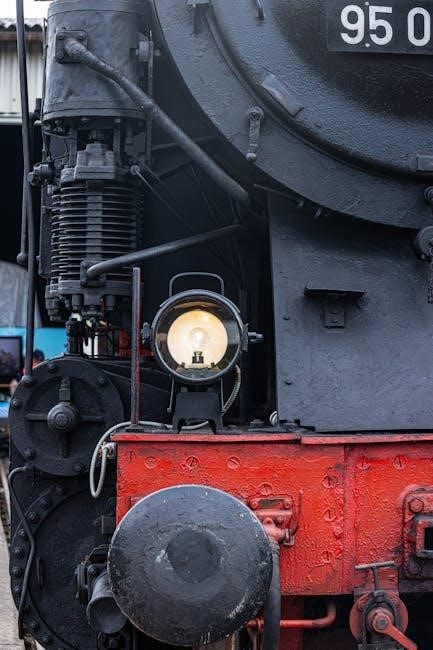
Case Studies and Real-World Applications
Real-world applications of steam boiler piping diagrams include industrial manufacturing, healthcare facilities, and educational institutions․ These diagrams ensure efficient installation, maintenance, and troubleshooting, optimizing steam system performance and safety․
10․1 Industrial Applications of Steam Boiler Piping
Steam boiler piping diagrams are crucial in industrial settings, such as manufacturing plants, food processing, and pharmaceutical facilities․ They guide the installation of steam distribution systems, ensuring efficient power generation, heating, and process steam delivery․ Proper piping layouts optimize energy use, reduce risks, and comply with safety standards․ Industrial applications often involve complex configurations, including venting systems, condensate return lines, and pressure relief valves, all detailed in piping diagrams to maintain system performance and reliability, minimizing downtime and operational costs․
10․2 Commercial and Residential Uses
Steam boiler piping diagrams are widely used in commercial and residential settings to ensure efficient heating and hot water systems․ In large buildings, they guide the installation of steam distribution networks for space heating and domestic water heating․ Residential applications often involve simpler layouts, focusing on reliability and safety․ Proper piping configurations, as detailed in PDF diagrams, help prevent issues like water hammer and corrosion, ensuring long-term performance and energy efficiency in both commercial and home environments․
10․3 Lessons Learned from Successful Installations
Successful steam boiler piping installations emphasize proper planning, adherence to best practices, and meticulous execution․ Key lessons include ensuring accurate pipe sizing, selecting durable materials, and implementing effective insulation to minimize heat loss․ Armstrong International’s resources highlight the importance of reverse return piping for balanced steam distribution․ Additionally, regular maintenance and compliance with safety standards are crucial for long-term efficiency․ These insights help avoid common pitfalls, ensuring reliable and energy-efficient steam systems in both commercial and industrial applications․
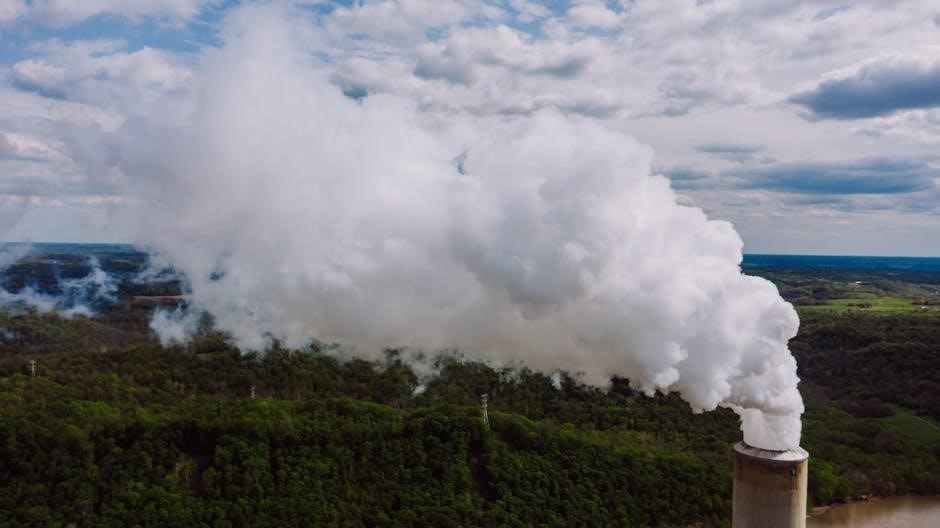
Future Trends in Steam Boiler Piping Systems
Future trends include advanced materials, smart technologies, and eco-friendly designs, enhancing efficiency, safety, and environmental performance․
11․1 Advancements in Piping Materials
Advancements in piping materials are revolutionizing steam boiler systems, with high-performance options like ASTM A53 steel pipe and wrought-copper fittings offering durability and efficiency․ These materials meet strict industry standards, ensuring reliability under high pressure and temperature conditions․ Modern piping systems also incorporate advanced alloys and corrosion-resistant coatings, reducing maintenance needs and extending system lifespans․ Such innovations align with global trends toward sustainable and long-lasting solutions for industrial and commercial steam applications․
11․2 Integration of Smart Technologies
The integration of smart technologies into steam boiler piping systems enhances efficiency and safety․ Advanced software tools like AVEVA PDMS and ROHR2 enable precise 3D modeling and pipe flexibility analysis․ IoT-enabled sensors monitor real-time pressure, temperature, and flow rates, enabling predictive maintenance․ Automation in piping design and analysis ensures compliance with standards like EN12952 and EN13480, optimizing performance and reducing downtime․ These innovations are transforming traditional systems into intelligent, adaptive solutions for modern industrial demands․
11․3 Environmental and Efficiency Improvements
Modern steam boiler piping systems prioritize environmental sustainability and energy efficiency․ Advanced materials and designs minimize heat loss and reduce emissions․ Optimized piping layouts and insulation strategies ensure maximum energy utilization․ Smart technologies integrate with piping systems to monitor and control energy consumption, promoting eco-friendly operations․ These improvements align with global sustainability goals, enhancing system performance while reducing environmental impact and operational costs․
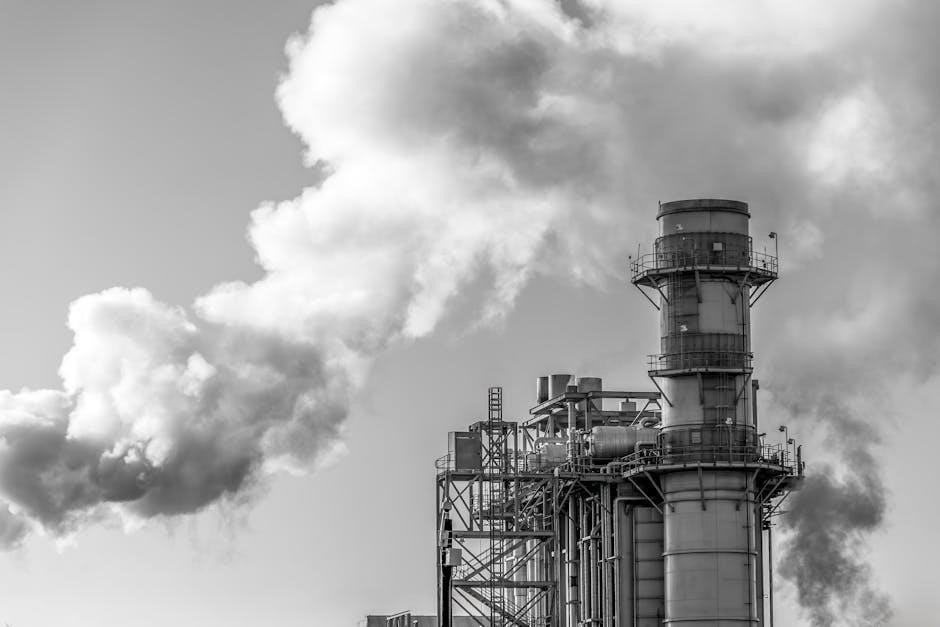
Resources for Further Reading
Key resources include Armstrong International’s piping guides, Bryan Boilers’ detailed diagrams, and industry standards like ASME B16․22 for comprehensive insights and practical configurations․
12․1 Recommended PDF Guides and Manuals
Armstrong International offers comprehensive Steam and Condensate Piping Diagrams in PDF format, providing detailed layouts and best practices for steam systems․ Bryan Boilers’ Single Boiler Piping Diagram PDF includes configurations for efficient steam distribution․ The Department of Veterans Affairs’ Standard Steam Boiler Plant Piping Diagram is another valuable resource, outlining proper piping arrangements and safety guidelines․ These guides are essential for engineers and technicians, ensuring compliance with industry standards and optimal system performance․
12․2 Industry Standards and Regulations
Adhering to industry standards and regulations is critical for designing and installing steam boiler piping systems․ Key resources include Armstrong International’s best practices for steam and condensate systems, Bryan Boilers’ detailed piping diagrams, and the Department of Veterans Affairs’ standard piping layouts․ Additionally, materials and fittings must comply with ASTM standards (e․g․, B 88 for copper tubing, A 53 for steel pipe) and ASME B16․22 for wrought-copper fittings․ European standards like EN 12952 and EN 13480 also provide guidelines for steam boiler piping․ Always ensure compliance with local building codes and ASHRAE guidelines for steam systems․
12․3 Online Communities and Forums
Online communities and forums provide valuable resources and insights for steam boiler piping systems; Platforms like Reddit’s r/Engineering and r/Plumbing, as well as specialized forums such as Steam Boiler Systems Forum, offer discussions, troubleshooting tips, and shared experiences․ Additionally, groups on LinkedIn and Stack Exchange often feature detailed Q&A sessions with industry experts․ These platforms also host downloadable resources, including piping diagrams and installation guides, making them indispensable for professionals seeking practical advice and updated information․
